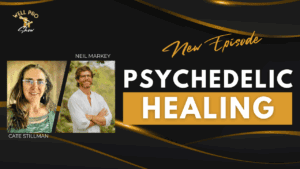Somatic Healing & Trauma Recovery with Elizabeth Stodder
Somatic healing is at the center of this powerful conversation between Cate Stillman and Elizabeth Stodder—somatic transformation coach and founder of the Body and Soul Sanctuary. In this episode, they explore how deep healing happens when people reconnect with their bodies, regulate their nervous systems, and experience the support of community. Elizabeth shares her personal journey through trauma and vaccine injury recovery, and how it led her to create a unique healing space rooted in safety, co-regulation, and embodied awareness.
1. The Origin of Body and Soul Sanctuary
Cate opens the episode by introducing Elizabeth’s journey as both a healer and a survivor. Elizabeth shares how a near-death vaccine injury radically altered her life, pushing her to understand the nervous system and healing at a deeper level.
This experience became the catalyst for creating Body and Soul Sanctuary, a space designed for individuals who need more than traditional care—those who need compassion, slowness, and community.
Her work is rooted in somatic transformation, bridging her lived experience with trauma-informed tools, ancient wisdom traditions, and modern neuroscience.
2. Why Trauma Requires Community, Not Isolation
A recurring theme in the conversation is the harmful narrative of being “broken.” Elizabeth explains how many people—especially those with trauma or chronic health challenges—internalize this story and isolate themselves. She emphasizes that healing accelerates in community, not in isolation.
The club model she uses creates:
- A shared healing space
- Opportunities for people to be witnessed
- A sense of belonging and normalization
- Collective support that eases shame and fear
For many, this is the first time they’ve been in a space where they don’t have to hide their symptoms or their story.
3. Learning to Listen to the Body
Elizabeth blends intuitive, ancient healing practices with modern nervous system science. She explains that healing begins when individuals shift from seeing trauma as “something wrong with them” to understanding it as:
- A cultural disconnection,
- A nervous-system response, and
- A call to slow down and listen to the body.
This reframing empowers people to trust their own sensations, boundaries, and intuition instead of suppressing their inner signals.
4. Challenging Cultural Norms Around Healing
Cate and Elizabeth also explore how cultural programming often disrupts healing. Modern systems—especially healthcare—tend to emphasize:
- Speed over slowness
- Symptom suppression over root-cause exploration
- Individualization over community
Elizabeth argues that this contributes to disconnection and prolonged suffering. Her work encourages people to question these norms and reclaim their healing from a place of sovereignty and self-awareness.
5. The Power of Co-Regulation & Connection
A core pillar of Elizabeth’s community is co-regulation—the way nervous systems calm and stabilize each other through safe, supportive presence.
She explains that healing environments must act as fertile “soil” where:
- Connection replaces isolation
- Nervous systems feel safe
- People can rewrite old patterns
- Emotional resilience naturally expands
Members experience profound transformations simply by being in a space where they are understood, validated, and connected.
Conclusion: What This Conversation Teaches Us
The dialogue between Cate Stillman and Elizabeth Stodder highlights transformative truths about healing:
- Trauma must be seen within cultural and systemic context.
- Community is essential—not optional—for genuine transformation.
- The body’s signals are invitations, not threats.
- Safe spaces and co-regulation accelerate emotional and physical healing.
- No one is “broken”—we are collectively awakening to what’s possible.
- Elizabeth’s work is a testament to what becomes possible when people are given the environment, validation, and community they’ve always needed.
Elizabeth Stodder shows that people aren’t “broken”—they’re disconnected from the support they need. When community, somatic practices, and trauma-informed care come together, healing becomes not just possible, but deeply transformative.


